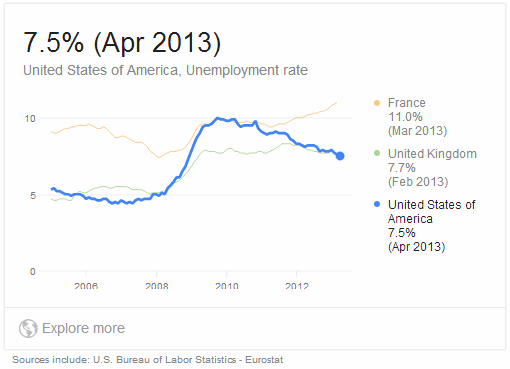Geoff Brandt asked the following question on Google Plus:
I was having a discussion with an acquaintance of mine who is somewhat more conservative than I am. He was railing against most gov’t spending (perpetrated of course by “those Liberals in Washington”) and insisted our nation’s top priority other than defense should be to pay down the national debt.
Now I’m fairly intelligent and I gave him a number of counter arguments about how govt stimulus has a better track record than gov’t mandated austerity when combating recession, but he wouldn’t budge.
So I’m throwing this out to the group in hopes of gaining a better understanding of just how lethal a govt deficit actually is. I know how personal debt can be a problem of course. But then again, unlike a sovereign nation, I can’t just print money when needed or flood the bond market (essentially becoming my own stimulus).
Anyone want to take a crack at the real pros and cons of running a perpetual debt at the federal level?
Now given the very contentious debate on Austerity versus Keynesian Economic Policy it was interesting to see the following answer to the question:
Two very interesting observations apply here. First countries are different with regard to debt than individuals or corporations. People have life cycles in which there debts have to be cleared at death. Corporations are more like governments and they can carry large debt loads as long as their earnings cover the debt and their repayment of principle on debt instruments can either be “turned over” or repaid. But they simply do not have the monetary size of national governments.
National governments do the same – so they tend to run perpetual debts. And the USA has been running a perpetual debt since its creation – that is 237 years with perpetual debt.
That national debt becomes onerous when two things happen – 1)the interest payments can’t be made to Government bondholders on a timely and contractual basis and 2)the total debt is being expanded to make those interest payments. In the past 237 years, the US has defaulted completely on its debt obligations – in 1782 and partially paying not on original bond terms but legislated partial payments.
These partial payment defaults occurred twice in the US. In 1862 during the Civil War Lincoln abrogated the terms of contract on US currency being convertible into gold. Greenback currency holders lost 20-40% of the equivalent gold conversion value if the notes were exchanged immediately. Then in 1934 on Liberty Bonds, President Roosevelt did the same – reneged on the 1917 Liberty War Bonds conversion to Gold terms. Again bondholders took haircuts of 20-45% of the gold equivalent value of the bonds. See here.
So yes, the US has had perpetual debts. And no it has not had a massive default in 231 years.
So what is the the level of debt that the US or any other country afford to have before it adversely effects the economic growth and well being of the country? Well this is the exact questions that 2 Harvard economists, Reinhart and Rogoff , attempted to answer and their study concluded that when National Debt as a percentage of Total National GDP crossed the 90% level then a tipping point was reached in which slow growth occurred. Now if you have been following Jay Donnell’s post below or any of Paul Krugman’s recent columns on the false premises of Austerity Measure Models during a Recession, you will see that this 90% tipping point analysis is becoming firmly discredited.
However, the Keynesian solution recommended by Paul Krugman and many others, which is to spend more in recessionary times [including deficit spending], is full of caveats. Three of the most important are: 1)Spend enough to make a difference [20M unemployed to reach half with a double above poverty line wages for 6 months would cost $140B in say an Infrastructure Repair program – that is 1/5th of current Defense spending in one year]; 2)spend in targeted ways on projects that have high GDP multipliers and direct if temporary job creation [this is where the spending has gone so wrong with the FED spending $85B per month to make trickle down money available to the banks and Job Creators]; and 3)Stop the Keynesian stimulus spending when the economy starts to recover [This is the most difficult caveat to achieve].
Now answer me this – do you see the US Congress with its bitter partisan bickering, being capable of doing this type of prudent Keynesian spending?
It appears one could add one more caveat condition to the above. And that the timing of the Keynesian stimulus spending has to be propitious. If you consider the US Unemployment rate chart below:
then the most effective timing for a stimulus push would have been in late 2008 or the first 3 quarters of 2009. But having rescued the banks and the Auto Industry, Congress was not willing to finance a recession-stopping infrastructure stimulus. True, high impact cuts to unemployment tax payments were made – but that is not spending on new jobs. So it appears that Congress is incapable of a)making targeted, high multiplier spending policy, b)time it close to right and c)make the right size stimulus. This is increasingly true with official unemployment at 7.5%and GDP growth at the 1-2% levels for the past few years. Congress continues to reject jobs rich Infrastructure Policy even though the revenues to workers reduce FoodStamp and Safety Net spending by government and increase tax revenues in personal and corporate income taxes. Do you get the impression that Congress, constrained by its Deficit Hawk Tea Party contingent, is part of the problem – not part of the solution to US Jobs and Economic recovery?

